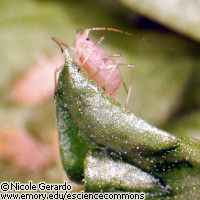Scientists sequence aphid genome
An international team of scientists has sequenced the genome of the pea aphid. As well as shedding new light on insect ecology and evolution, the results could lead to the development of new ways of controlling aphids, which are major agricultural pests. The findings are published in the journal Public Library of Science (PLoS) Biology, while accompanying papers can be found in PLoS Genetics, Genome Biology and a special issue of Insect Molecular Biology. Aphids live on plants using specialised mouth parts to tap into the structures that transport sugars around plants. There are around 5,000 species of aphid worldwide, and many of them attack agricultural crops and ornamental plants. As well as damaging the plants by feeding on them, aphids often harm plants indirectly by carrying plant viruses. 'Annual worldwide crop losses due to aphids are estimated at hundreds of millions of dollars,' the researchers write. In this study, the scientists focused on the pea aphid (Acyrthosiphon pisum), which, as its name suggests, feeds on peas and other legumes. The first surprise for the researchers was the sheer number of genes the pea aphid has. 'We found a lot of genes - 35,000, compared to 15,000 to 20,000 in other insects, and 25,000 in humans,' commented Stephen Richards of Baylor College of Medicine in the US. This raises the question of why the aphid has so many genes. It is likely that the aphid duplicated some of its genes. 'What does this mean? It means that the pea aphid probably did a kind of 'backup' of its genetic material,' said Denis Tagu of the French National Institute for Agricultural Research. 'One hypothesis is that one copy of this backup is kept unchanged and used for the functioning of the cells and the organism, and the second set can allow modifications by mutations.' 'Most of the mutations are probably neutral or negative for the genes, with no effects on the biology of the organism,' added David Stern of Princeton University in the US. 'But some rare mutations might produce new functions for some of the genes that might help, in this case, the pea aphid adapt to its environment. Another possibility is that maybe aphids require extra copies of genes to regulate all parts of their complex life cycles.' Aphids have developed a number of different forms to cope with changing environments. In the spring and summer, asexual females give birth to live asexual offspring that are effectively clones of themselves. However, when autumn arrives and the environment becomes more hostile, the aphids produce sexual females and males. When these mate, the females lay eggs which hatch in the spring to produce asexual females, and the whole cycle begins afresh. There are also winged and wingless forms; the winged forms are able to travel further and colonise new plants, for example. Another revelation for the researchers was the absence of many genes involved in the immune system. 'Given these missing genes, it seems that aphids have a weak immune system,' noted Nicole Gerardo of Emory University in the US. One possible explanation is that the aphids sacrificed a strong immune system in exchange for the ability to reproduce rapidly. 'It is likely that aphids are selected for extremely high rates of reproduction; they have to colonise a plant and produce offspring before their enemies find and [exterminate] them,' said Charles Godfrey of the University of Oxford in the UK. 'We know there are trade-offs between defence and other fitness components and in aphids natural selection may have favoured reproduction over defence.' Another possibility is that their weakened immune system stops the aphids from killing off their symbiotic bacteria. The aphid diet of sugars sucked from plants lacks essential amino acids. These are provided by symbiotic bacteria called Buchnera which live inside special cells in the aphid and are passed on from generation to generation. Studying this system could have implications for human health. 'Some people feel sick when they take antibiotics because the drug kills off all the beneficial bacteria [in the human gut],' said Dr Gerardo. 'If we can study the process of how to keep beneficial bacteria while clearing out harmful bacteria across several organisms, including aphids, we might be able to understand it better.' The findings also lead to improved crop protection. 'Understanding the molecular dialogue between bacterial and aphid genes could lead to discovery of key regulatory mechanisms that can decrease the efficiency of the symbiosis and disrupt the aphid's impact on crops,' Dr Tagu pointed out. 'Biologists working on the pea aphid now have a valuable new set of tools to attack novel questions,' concluded Professor Godfrey. 'Studies on the pea aphid will inform our understanding of aphid biology and of insects more generally, with clear economic benefits at a time of increasing food security.'



